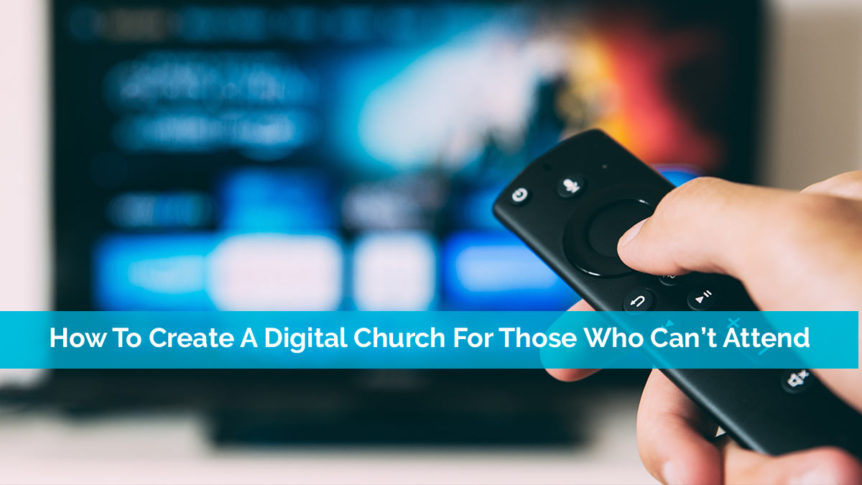During COVID-19, churches are struggling to keep their members connected. However, the one positive out of all this is many churches are learning to create a digital church for those who can’t attend.
It’s important to remember that social distancing isn’t something that only applies during pandemics. Any time a member thinks they might be sick, they should stay home from church. Of course, higher-risk members may prefer staying home during the peak of flu season.
Even if people can’t attend in person for any reason, they shouldn’t feel like they can’t still worship as part of your church family. Now is the perfect time to start setting up a digital version of your church for your members and anyone worldwide who may want to worship with you.

Create A Church Website
The first step is to create a church website. Your website serves as the central home as you create a digital church. This is where people will go to view services, learn about upcoming events, engage with blog posts and much more.
We personally recommend that your site has at least six main pages. These include:
- Home
- About Us
- Ministries
- Events
- Sermons
- Giving
All of these can have interactive digital elements. For instance, your Home page will be filled with details about service times and set the tone for your church’s online personality, which should be the same as your church.
You can link to corresponding social media ministry groups for online interactions on your Ministries page. Of course, online tithing is important, so add online giving options on your Giving page.
The only other page you might want to add is a Blog. If you’re new to blogging, use our guidelines for creating a blogging strategy for your church. Blogs are even a great way to boost dwindling membership and visitor numbers.
Build A Social Media Presence
While you can have a lot of interactions on your church website, especially viewing church services, you still need a second element – social media. Based on 2020 social media trends, people enjoy interacting with others via social media. Their favorite aspects are videos, private groups and group messaging apps, such as Messenger.
Social media is a free way to bring your church family together. When members can’t attend, they miss the social element, even if they view your services online. After services are over, encourage them to head to your social media channels to talk with other members.
You may even want to set up specific social hours on the platforms you use. These will be the hours that church leaders are available to interact with members.
Social media is a bit intimidating, but don’t worry. All you need is one platform to start with. Since Facebook is the most popular, it’s a great place to start. Plus, you can utilize Messenger for private individual chats and group chats.
Focus on being active on social media throughout the week. Ask a few volunteers or other church leaders to help out. Our social media strategy guide will help you learn how to make social media successful for your church.
Get The Right Equipment
The good news is you may not need any expensive equipment to create a digital church. There are three main things you’ll need – a camera, a microphone and a computer. If lighting is an issue, you may also need a separate light to better show the pastor and choir.
Many smartphones have great recording capabilities. With a nice stand, you could easily use a smartphone for live streaming and recording services. Obviously, you’ll need a microphone so people online can hear you better. Depending on your camera, the built-in mic may be enough to pick up what you’re saying.
If you want to invest in higher quality streaming and services, you can buy a higher quality camera/microphone setup. If you’re considering buying a $1,000 phone just for this purpose, you’re probably better off getting a dedicated camera meant for live streaming.
You’ll also need a live streaming platform, which we’ll cover more later on. However, this isn’t a necessity if you’re simply recording services to show later.

Test Your Recording
One of the most common mistakes churches make with live streaming and recording is not testing things first. Imagine getting excited about your first recording only to have members start complaining that they couldn’t hear anything. Or, you sounded great, but the video was so fuzzy they couldn’t see it.
Before you go live, set up everything and test it out. Make sure the video looks and sounds great. It’s better to make adjustments before than spend your entire service trying to work out the kinks.
Ideally, test your equipment at least an hour before each service. This gives you time to work out any issues.
Choose Live Or Recorded
You have three main options for showing services and events when you create a digital church. The first is live streaming only. This usually isn’t the best idea as some people may not be attending church due to other obligations during church services, such as work or an important doctor’s appointment.
The second option is a recording only. This works well if you just want to offer people a way to view your services after they’re over. You simply record during the services and upload the video to your website or other platform later.
The best option is a live streaming and recording combination. You live stream initially, but leave the video available for people to watch later. It gives members everything they could ask for. It honestly doesn’t cost anything more to do both.
Host Yourself Or Elsewhere
No matter which approach you take, there’s one other thing to consider – where to host the videos and/or streams. You can host everything yourself, but you have to make sure your web host can handle it.
When you buy web hosting, you’re limited to a certain amount of bandwidth and storage. Even unlimited plans actually have limits in the fine print. If your church is on a budget, you probably have shared hosting, which means you’re sharing resources with other sites. If they have a spike in traffic, it could affect your live streaming.

There’s no reason not to host everything on your own website if you have ample bandwidth and space. Even if you only have space to store videos, your website makes a great home for recordings after the fact. The only problem with doing it all from your own site is you also have to ensure everything is configured and uploaded correctly.
If you can’t or don’t want to host everything yourself, you have plenty of other options. Our guide to live streaming lists both premium and free options for hosting your live streams. Facebook Live and YouTube Live are both free and help your church get online without as much of an initial investment.
It is worth noting that some premium services do have their own equipment for you to rent and/or buy and use. Plus, they handle much of the configurations so you can just start. Obviously, they do have monthly fees, but some start as low as $15 a month.
Even if you use a live streaming platform, you can still host your recorded streams on your own website later. You can also just link to them. For instance, you might upload services to YouTube and link to them from your website.
Talk with your members and church leaders to determine which option is best for your church.
Provide Online Office Hours
If people can’t attend church in person, they might not be able to visit the pastor during office hours either. For instance, someone who’s sick and contagious, but still wants the pastor to pray with them could video chat with the pastor during online office hours.
During this period, people can schedule appointments or even have group chats. For those who don’t need video, they can use a chat function on the church website or engage via social media.
Ideally, have a few church leaders or volunteers to help out. As you create a digital church, you may have more than just your members attending. This could make your online office hours a bit busy. Having extra people to answer questions and handle certain requests will help.
Offer Special Online Worship Resources
Obviously, you can’t be online 24/7 for your members. However, this doesn’t mean you can’t still provide them with special online worship resources. For example, online prayer is becoming increasingly popular.
In fact, the Church of England prayer apps were used 4.2 million times between October 2018 and October 2019. Church of England also posts social media prayers which reach an average of 3.6 million worshippers every month.
While online resources might not be exactly the same as being in church, the right resource to the right person could change their entire life. That one online prayer or blog post could serve as a major turning point or uplift them after a major tragedy.
Some resources to consider providing include:
- Online prayer – Website, social media and even a church app (if you don’t have one right now, see how online prayer goes on your site and social media first)
- Engaging blog posts – More details on sermon series, discussing current events, addressing common obstacles
- Social media groups – Give people a place to talk to others
- Daily devotionals and/or suggested reading – Keep people worshipping all week long
- Links to suggested Christian apps – Bibles, prayer apps, streaming Christian music
- Links to Christian podcasts or start your own – Offer worship resources from a variety of sources
- Things for kids – Christian coloring pages, Christian projects, children’s stories
While this isn’t everything you could offer, it’s a great start. If you’re serious about creating a digital church, consider adding a “Digital Worship Resources” or “Worship Resources” page to your site with full details of your digital presence and links to worship resources on your site and social media.

Encourage An Active Social Media Community
Social media is a large part of your digital church. While you should make sure your sermons and at least some other worship resources are available on your website for members who don’t use social media, many people want to feel more like a community, even online.
Social media gives you the closest thing to community as you can get online. People can jump in whenever they want to ask a question or interact with like-minded people.
Encourage your members who attend church in person to interact on social media as well. This helps keep your church family connected, even if some members can’t attend temporarily or longer-term.
Part of an active community is getting involved yourself. Don’t leave it up to your members. Church leaders need to be active too. Post content regularly and talk to your social media followers. Host special Facebook Live sessions for more interaction.
Another idea is to create online ministry groups. Create them based on what your members need. For instance, you might have one for kids, another for teens and another for adults. Make sure you have moderators for every group and set them to closed or private so you can monitor who wants to join to keep troublemakers out.
Listen To Member Feedback
If this is all new to your church, it might be a bumpy road at first. Don’t give up. Right now, especially, your members understand that you’re trying to create a digital church nearly overnight. However, let your members help you.
Set up a form on your church website (make sure it works) to let members and any site visitors provide feedback. Ask for feedback on social media too.
Not only will you quickly learn what’s not working, but you’ll get ideas on how to improve. Let your members tell you what resources they wish they had. Pay attention to what they interact with most on social media. Ask them for blog post topics.
Measure Overall Engagement
As you’re working on this, try to measure overall engagement. For instance, if you set up accounts on Facebook, Twitter and Instagram, see which platform(s) are working best for your church. If 95% of your engagement is on Facebook, it may be time to focus all your efforts there for now.
A church website is the first step to creating your own digital church for those who can’t attend. Contact us today to find out how we can help.




